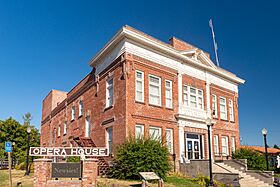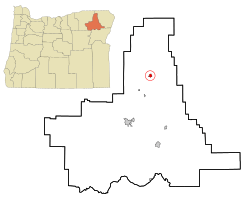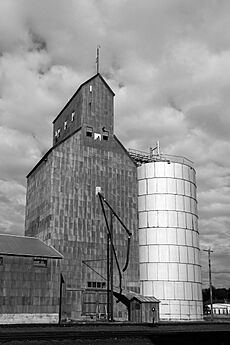Elgin, Oregon facts for kids
Quick facts for kids
Elgin, Oregon
|
|
|---|---|

Elgin Opera House and City Hall
|
|
| Nickname(s):
Jewel of the Blue Mountains
|
|

Location in Oregon
|
|
| Country | United States |
| State | Oregon |
| County | Union |
| Incorporated | 1891 |
| Area | |
| • Total | 1.01 sq mi (2.62 km2) |
| • Land | 1.01 sq mi (2.62 km2) |
| • Water | 0.00 sq mi (0.00 km2) |
| Elevation | 2,687 ft (819 m) |
| Population
(2020)
|
|
| • Total | 1,717 |
| • Density | 1,698.32/sq mi (655.78/km2) |
| Time zone | UTC-8 (Pacific) |
| • Summer (DST) | UTC-7 (Pacific) |
| ZIP code |
97827
|
| Area code(s) | 541 |
| FIPS code | 41-22550 |
| GNIS feature ID | 2410422 |
| Website | www.cityofelginor.org |
Elgin is a city located in Union County, Oregon, in the United States. In 2020, about 1,717 people lived there. The city got its name from a ship called the Lady Elgin, which was lost in Lake Michigan.
Elgin is famous for the Elgin Opera House, which first opened its doors in 1912.
Contents
History of Elgin
Elgin was first settled by hunters, trappers, and people from many different backgrounds. Traveling to Elgin from nearby La Grande was very difficult. The journey was 120 miles by river through thick forests. Today, it's only about 20 miles by road using Wallowa Lake Highway.
Elgin became a place where trappers and hunters could get new supplies. Early settlers also came from Walla Walla, crossing the Blue Mountains sometimes using dog sleds. The first settlers included Mr. McKinnis and his family. He brought cattle from Illinois and built one of the first homes in 1864. Mr. McKinnis also built mills and worked in the first bank in Elgin.
How Elgin Grew
The area where Elgin is located was once called "Fish Trap" and "Indian Valley." The city was officially planned out in 1886. This happened after a road called Ruckles Road was washed out over the Blue Mountains. This event caused people who had invested in nearby Summerville to move to Elgin instead.
By 1887, Elgin had several important businesses. These included general stores, a place to keep horses (a livery), a hotel, and a church. There was also a sawmill nearby, which is still a modern Boise Cascade mill today. Between 1887 and 1908, the area around Elgin had 35 sawmills. Most of these were portable mills that used water power. Landowners would sell trees for a small amount of money. The sawmills could process a lot of wood each day.
Growth in Elgin really picked up when the Oregon Railway & Navigation Company railroad arrived in November 1890. This railroad branch line came from La Grande, Oregon. The railroad was later extended from Elgin to Wallowa, Oregon and Joseph, Oregon in 1908. Elgin officially became a city on February 18, 1891, when the Oregon Legislative Assembly approved it.
Geography and Climate
Where is Elgin Located?
According to the United States Census Bureau, Elgin covers about 1.01 square miles (2.62 square kilometers) of land. There is no water area within the city limits.
Elgin is located where two important roads meet: Oregon Route 82 and Oregon Route 204. A popular spot for camping, Jubilee Lake, is about 19 miles (31 km) north of Elgin. It is located in the Umatilla National Forest.
What is Elgin's Climate Like?
Elgin has a type of climate called a warm-summer Mediterranean climate. This means it has warm, but not extremely hot, and dry summers. The average monthly temperatures do not go above 71.6°F (22°C). On climate maps, this is shown as "Csb."
| Climate data for Elgin | |||||||||||||
|---|---|---|---|---|---|---|---|---|---|---|---|---|---|
| Month | Jan | Feb | Mar | Apr | May | Jun | Jul | Aug | Sep | Oct | Nov | Dec | Year |
| Record high °F (°C) | 65 (18) |
68 (20) |
78 (26) |
91 (33) |
98 (37) |
101 (38) |
108 (42) |
110 (43) |
103 (39) |
92 (33) |
73 (23) |
64 (18) |
110 (43) |
| Mean daily maximum °F (°C) | 38.1 (3.4) |
44.1 (6.7) |
51.8 (11.0) |
60.6 (15.9) |
69.3 (20.7) |
76.6 (24.8) |
87.1 (30.6) |
86.9 (30.5) |
78.1 (25.6) |
64.4 (18.0) |
47.6 (8.7) |
39.7 (4.3) |
62 (17) |
| Mean daily minimum °F (°C) | 21.7 (−5.7) |
24.6 (−4.1) |
28.1 (−2.2) |
32.5 (0.3) |
38 (3) |
43.4 (6.3) |
46.4 (8.0) |
44.7 (7.1) |
37.9 (3.3) |
31.7 (−0.2) |
27.6 (−2.4) |
23.7 (−4.6) |
33.4 (0.8) |
| Record low °F (°C) | −27 (−33) |
−26 (−32) |
−17 (−27) |
11 (−12) |
17 (−8) |
26 (−3) |
29 (−2) |
25 (−4) |
19 (−7) |
8 (−13) |
−24 (−31) |
−31 (−35) |
−31 (−35) |
| Average precipitation inches (mm) | 2.95 (75) |
2.5 (64) |
2.18 (55) |
1.79 (45) |
1.89 (48) |
1.6 (41) |
0.65 (17) |
0.72 (18) |
1 (25) |
1.86 (47) |
3.12 (79) |
3.37 (86) |
23.63 (600) |
| Average snowfall inches (cm) | 14.8 (38) |
7.4 (19) |
3.2 (8.1) |
0.5 (1.3) |
0 (0) |
0 (0) |
0 (0) |
0 (0) |
0 (0) |
0.1 (0.25) |
4.6 (12) |
11.3 (29) |
41.9 (106) |
| Average precipitation days | 13 | 12 | 13 | 11 | 10 | 9 | 4 | 5 | 6 | 9 | 13 | 13 | 118 |
Population of Elgin
| Historical population | |||
|---|---|---|---|
| Census | Pop. | %± | |
| 1890 | 227 | — | |
| 1900 | 603 | 165.6% | |
| 1910 | 1,120 | 85.7% | |
| 1920 | 1,043 | −6.9% | |
| 1930 | 728 | −30.2% | |
| 1940 | 997 | 37.0% | |
| 1950 | 1,223 | 22.7% | |
| 1960 | 1,315 | 7.5% | |
| 1970 | 1,375 | 4.6% | |
| 1980 | 1,701 | 23.7% | |
| 1990 | 1,586 | −6.8% | |
| 2000 | 1,654 | 4.3% | |
| 2010 | 1,711 | 3.4% | |
| 2020 | 1,717 | 0.4% | |
| U.S. Decennial Census | |||
What the 2010 Census Showed
In 2010, the census counted 1,711 people living in Elgin. There were 714 households and 482 families. The city had about 1,728 people per square mile (667 people per square kilometer). There were also 778 housing units.
Most of the people living in Elgin were White (95.3%). A smaller number were Native American (1.3%), African American (0.2%), or Asian (0.2%). Some people were from other races or from two or more races. About 3.3% of the population was Hispanic or Latino.
About 31.4% of households had children under 18 living with them. More than half (51.5%) were married couples. About 10.4% had a female head of household with no husband present. And 5.6% had a male head of household with no wife present. About 8.9% of households had someone aged 65 or older living alone. The average household had 2.40 people, and the average family had 2.85 people.
The average age of people in Elgin was 43.9 years old. About 24.1% of residents were under 18. About 17.8% were 65 years or older. The population was almost evenly split between males (51.4%) and females (48.6%).
Famous People from Elgin
- Earl Avery Thompson (born in Elgin) was an inventor. In 1923, he invented the synchronizer for manual car transmissions. He also led the team at General Motors Corporation that created the first Hydramatic automatic transmission in 1940.
- Byron "By" Speece (born in Elgin) was a professional baseball player. He played for the Washington Senators, who won the World Series in 1924.
See also
 In Spanish: Elgin (Oregón) para niños
In Spanish: Elgin (Oregón) para niños


